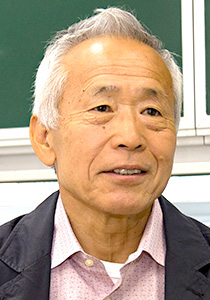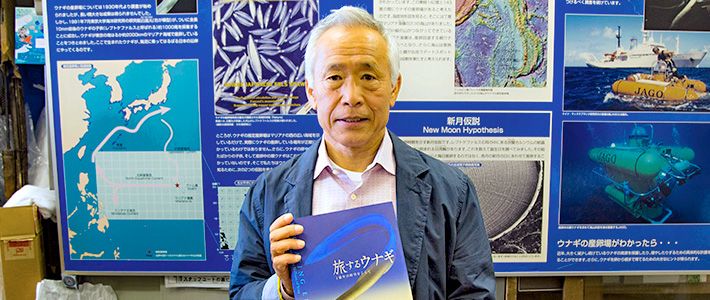
Stalking—and Saving—the Wild Eel: An Interview with Marine Biologist Tsukamoto Katsumi
Society- English
- 日本語
- 简体字
- 繁體字
- Français
- Español
- العربية
- Русский
INTERVIEWER In November last year, you founded the East Asia Eel Society with the participation of experts from China, South Korea, and Taiwan, as well as Japan. How did that come about? What are the organization’s aims, and how does it plan to achieve them?
TSUKAMOTO KATSUMI The East Asia Eel Resource Consortium, which was the forerunner of the East Asia Eel Society, has been active for almost twenty years, ever since 1998. But it was more in the nature of a private group organized and run by my research team. We decided we needed a full-fledged international society open to a wide range of participants to facilitate the exchange of scientific information on the eel. We started out with about a hundred members—primarily scientists, but also people in the fishing and seafood industries, amateur eel enthusiasts, and so forth. Having an academic platform makes it easier to share information that can provide a scientific basis for resource management and conservation policies. That was another benefit we had in mind.
One of our goals is to establish “eel science” as an academic field in its own right. We also want to educate the public about it. The issues surrounding resource management are closely tied up with the way we function as a society. If we want to keep unagi as part of our diet, we need to study the issue from a cultural angle as well as a scientific standpoint. I’d like to see eel science develop into a multidisciplinary field that integrates natural science, social science, and the humanities.
Inching Toward Conservation
INTERVIEWER The Japanese eel is officially an endangered species. Still, we hear that unagi is increasingly popular among diners in Taiwan and China. Glass eels [transparent juveniles] continue to be harvested in great numbers from estuaries around East Asia, raised to maturity on eel farms, and consumed. To what degree are people around the region conscious of the need to protect the species?
TSUKAMOTO Japan is the most acutely aware of the problem. That’s why our Fisheries Agency has taken the lead in the four-way talks [with China, South Korea, and Taiwan] on eel conservation and resource management launched in 2012. The Taiwanese also have a fairly high level of awareness. The Chinese, not so much. South Korea probably falls about midway between Taiwan and China.
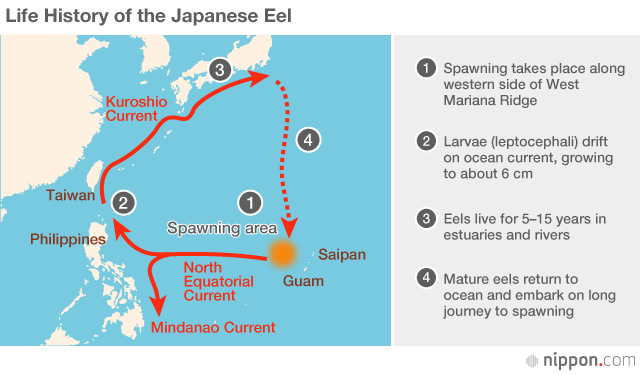
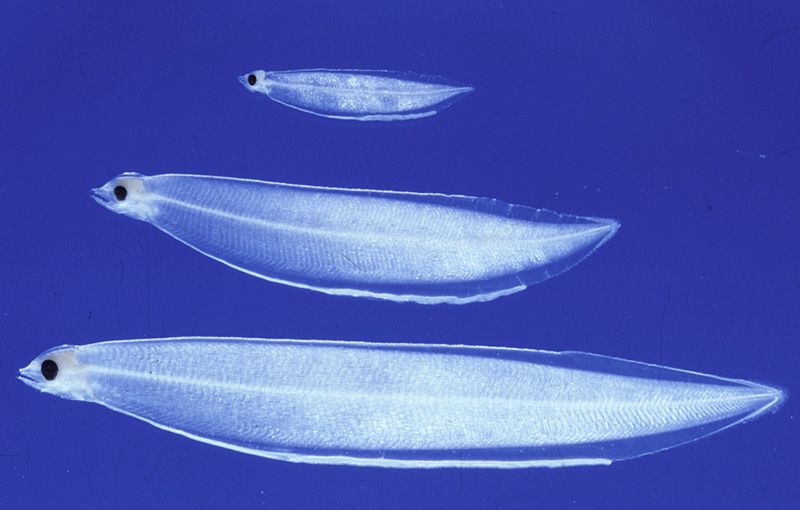 Larvae (leptocephali) of Japanese eel. (Photo courtesy of Tsukamoto Katsumi.)
Larvae (leptocephali) of Japanese eel. (Photo courtesy of Tsukamoto Katsumi.)
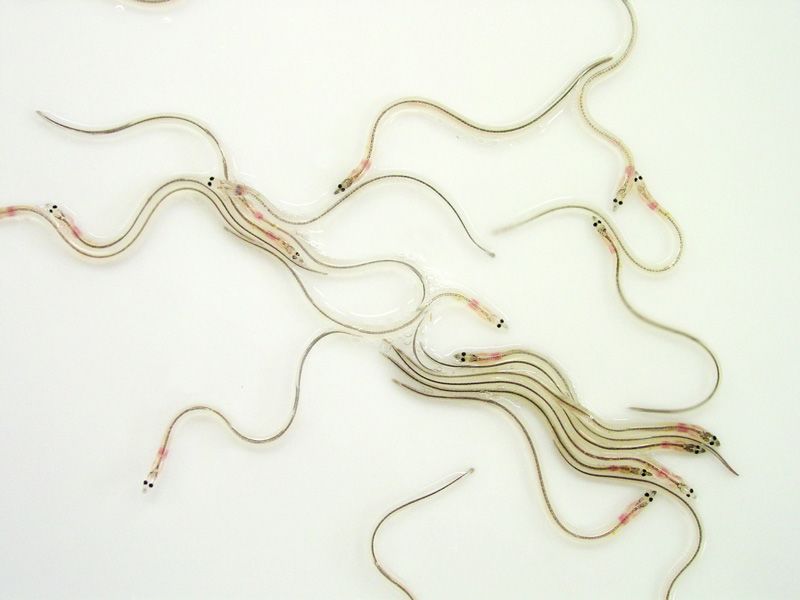 Glass eels (transparent juveniles), also known as elvers. (Photo courtesy of Tsukamoto Katsumi.)
Glass eels (transparent juveniles), also known as elvers. (Photo courtesy of Tsukamoto Katsumi.)
Japanese researchers have been working to develop full-cycle eel aquaculture ever since the 1960s. Even then, people in fisheries management and industry were concerned about stock levels. That’s because the number of glass eels arriving on our shores fluctuates widely from year to year. But the average number of landings used to be much higher. Since the 1970s, there’s been a sharp downward trend, and now their numbers fluctuate at a much lower level. Unfortunately, no one has been able to develop a commercially viable method of breeding eels in captivity. In the wild, they spawn far out in the open sea, so no one yet has been able to pin down the exact conditions for reproduction. All the farm-raised unagi we eat today is grown from wild-caught glass eels.
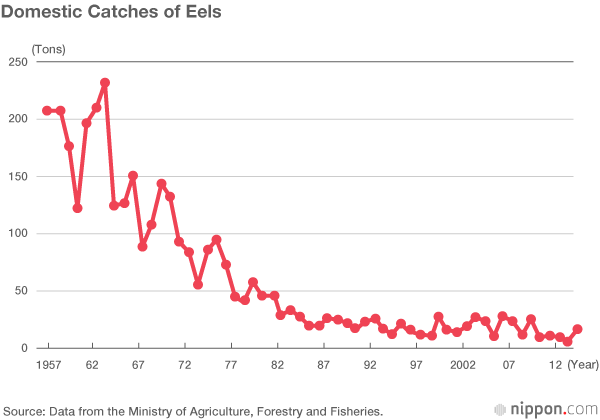
A Call for Restraint
INTERVIEWER In 2013, when the glass eel catch fell to just five tons, there was a widespread feeling of panic in Japan. People were afraid that unagi was going to disappear from the menu forever. In 2014, the International Union for Conservation of Nature designated the Japanese eel an endangered species, and after that, the Japanese government took a few steps to protect stocks, such as requiring eel farmers to be licensed and imposing limits on glass-eel procurement. So, where do things stand now, three or four years later?TSUKAMOTO I would say consumers are getting used to thinking of unagi as a scarce and expensive item. Around 2000, the Japanese were consuming more than 100,000 tons of eel annually, much of it imported from China. In the prepared-food section of Japanese department stores, the counters were laden with grilled unagi at throwaway prices. Then international trade in European eels was banned, imports from China [where European eels were being farmed] plummeted, and prices went up.(*1)Over the past four years, scientists like myself have been warning that we’re in danger of depleting our stocks of Japanese eel if we don’t consume them more sparingly, and I think consumers are beginning to get the message.To conserve and replenish our eel fisheries, the main thing we need to do is protect the adult eels and make sure that as many as possible return to the ocean to spawn. These eels are an international resource; all four East Asian countries have to work together to protect it. As a major producer, China is a big piece of the puzzle. I’m hopeful the Chinese will do their part to save the eels by addressing environmental issues in their waterways and limiting catches of glass eels. I’d like to see catches dialed back to where they were forty or fifty years ago.INTERVIEWER What’s your advice to Japanese consumers who love their unagi?TSUKAMOTO The Japanese really should cut back a bit on their consumption of eel. But this is also an admonition to retailers, who continue to do everything possible to encourage mass consumption. Granted, there are a few responsible ones out there who are saying, Yes, unagi is a shining example of Japanese food culture, but we need to consume responsibly if we want to preserve it for generations to come. But the vast majority of retailers take the attitude that, if it’s profitable, then of course they’re going to sell as much as they can. In terms of consumer behavior, we advocate limiting one’s consumption of unagi to a few special days out of the year. I would like consumers to understand the situation facing the Japanese eel and treat unagi as a somewhat extravagant indulgence for special occasions.
In terms of consumer behavior, we advocate limiting one’s consumption of unagi to a few special days out of the year. I would like consumers to understand the situation facing the Japanese eel and treat unagi as a somewhat extravagant indulgence for special occasions.
(*1) ^ Annual consumption is now around 50,000 tons. —Ed.
The Riddle of Reproduction
INTERVIEWER As a scientist on the cutting edge of research into the behavior of the Japanese eel, you’ve made it your next goal to observe the eels in the act of spawning. Can you explain the importance of this research? And did you make any progress on your latest expedition to the Marianas this past May?
TSUKAMOTO How the male and female eels manage to find one another to reproduce within the vastness of the ocean is truly a mystery, and no one has witnessed it actually happening. But we’ve been able to piece together a good deal about the process, largely from laboratory experiments and observations.
 A Japanese eel egg collected along the western side of the West Mariana Ridge. (Photo courtesy of Tsukamoto Katsumi.)
A Japanese eel egg collected along the western side of the West Mariana Ridge. (Photo courtesy of Tsukamoto Katsumi.)
During the daytime, the adult eels avoid predators that rely on their sense of sight by staying deep underwater [about 800 meters below the surface], where it’s completely dark and very cold. At night, they come up closer to the surface [about 200 meters underwater], where it’s warmer. Near the time of the new moon, the females ovulate in response to the higher temperatures in the shallow depths. At that time they emit a pheromone that attracts the males. The male bumps the female’s gills and belly to stimulate spawning, and the female releases a huge number of eggs, which the male fertilizes. This is what we’ve been able to surmise, but it’s based on the laboratory behavior of eels that were brought to maturity with artificial hormone treatment.
We need to actually observe this process taking place in the wild to determine how many males and females need to gather, and in what ratio, in order to reproduce effectively, and to figure out the precise physical, chemical, and biological requirements for an aggregation site. This information could provide crucial hints for managing and increasing stocks.
 Large plankton net (3 meters in diameter) used by the research team to collect eel eggs and larvae. (Photo courtesy of Tsukamoto Katsumi.)
Large plankton net (3 meters in diameter) used by the research team to collect eel eggs and larvae. (Photo courtesy of Tsukamoto Katsumi.)
Furthermore, if we could establish the exact conditions under which the eels mature and spawn, it would aid in the development of full-cycle aquaculture, since that information should allow breeders to control the environment in such a way as to dramatically improve the quality of the eggs produced in captivity.
Unfortunately, as far as we can tell from our onboard observations, we didn’t manage to observe a spawning event on this year’s expedition. But we’re going to continue analyzing a wide array of observational data, including photographic images taken by our submersible and deep-sea cameras, to gather more detailed information.
Clues from Environmental DNA
On our 1991 voyage, we collected leptocephali [eel larvae] and analyzed them to get a general location of the eels’ spawning grounds. This was a large elliptical zone roughly 100 kilometers by 200 kilometers. In 2009, we succeeded in collecting eggs for the first time and were able to narrow down the location of the spawning grounds to within about 10 kilometers. We’ve also concluded that spawning occurs at a depth of around 200 meters. But the whole event is over before you know it, so if we want to have a decent chance of witnessing it, we need to be able to pinpoint the location to within a few hundred meters at the most.
The biggest achievement of our latest voyage was the application of a new technology, analysis of “environmental DNA,” which allows us to detect DNA from mature eels in samples of seawater. Our results suggest that we can use this technique to narrow down the location of the spawning site from 10 kilometers to several hundred meters.
We estimate that the peak of spawning activity occurs about three days before the new moon. On our latest expedition, we saw early indications of spawning activity in the eDNA five days before the new moon. Three days before the new moon we detected an abundance of DNA signals. I believe that spawning occurred not far from where we were.
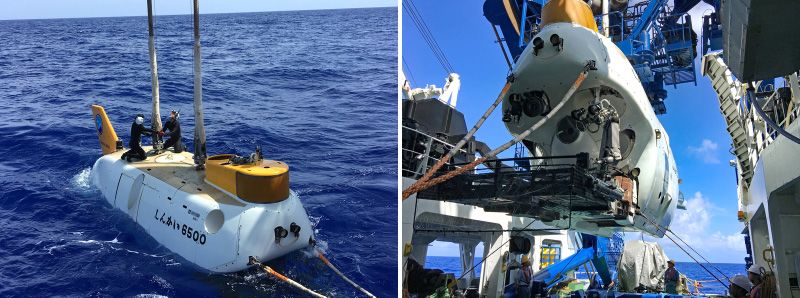 The Shinkai 6500 manned submersible used in the team’s research. (©JAMSTEC)
The Shinkai 6500 manned submersible used in the team’s research. (©JAMSTEC)
Eel Appeal
INTERVIEWER As a biologist, what do you find most appealing about the freshwater eel?
TSUKAMOTO Eels are such strange fish that you sometimes wonder if they’re fish at all. They have no obvious fins except for the pectoral fins. The larval stage is also unusual; the leptocephali look nothing like the adult eels. And then you have those marvelously long, twisty, slimy bodies. Freshwater eels have amazing abilities. For example, they can breathe through their skin, so in a moist environment, they can survive on land for two or three days. They can also climb up a large waterfall.
But it’s their migratory behavior that I find the most fascinating. They swim thousands of miles just to return to the same area to spawn. How do they know where to go? How do they choose the spot? Why do they have to make such a long journey to start with? It’s just a continual source of wonder.
Japan is at the forefront of scientific research on freshwater eels. We’ve collected both adults and eggs from the spawning area of the Japanese eel and were even able to identify a specific spawning site. And our commercial aquaculture methods are the most advanced in the world.
Our researchers have already developed a closed-loop process that allows them to breed multiple generations in captivity, but it isn’t yet viable on a commercial scale. At the moment, the cost amounts to several thousand yen per glass eel. They need to get that down to well below a hundred yen to make it commercially viable. At a few hundred yen, the juveniles could probably be sold to eel farmers if elver landings were to drop sharply.
I’m hoping that, with a little more work, they’ll come up with a commercially viable method of producing glass eels in captivity. If eel farmers could raise their eels from those artificially bred elvers, it would greatly reduce the pressure on stocks of wild eels and open the way for sustainable use of this precious resource.
(Originally published in Japanese on June 26, 2017, based on an interview by Ishii Masato. Interview photographs by Ōtani Kiyohide.)
